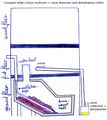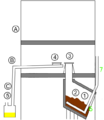A composting toilet is a waterless toilet that uses composting to treat excreta, typically with no water or small volumes of flush water, via composting or managed aerobic decomposition.[1]
Advantages of compost toilets[edit | edit source]
Toilet systems that dispose (processed or raw) human feces directly into the soil (ie pit latrines and flush toilets hooked upto a septic tank connected to a drain field) can contaminate waterlogged and high water table areas. This puts people at risk of catching cholera, dysentery, diarrhoea, jaundice, typhoid, polio and intestinal worms.
In waterlogged areas where there was previously no satisfactory sanitation system operating, the benefits that compost toilets provide are clear. They can prevent ground and surface water contamination and protect people's health in areas where open defecation on the ground or directly into water bodies has been the norm. The production of safe compost and effective use of the urine and wash water are also a significant benefit.
Composting toilets also protect surface and ground water from sewage pollution. Unlike flush toilets, composting toilets do not produce sewage and do not smell. They save huge quantities of water.
The use of compost toilets means that cities and peri-urban areas do not need to extend capital intensive sewerage networks and sewage treatment plants. In addition, no septic tanks, and no dangerous emptying of hazardous sludge needs to be performed. The recurring cost of maintaining additional infrastructure is also avoided. Both these factors represent a huge saving. Also, in areas where toilets would be flushed with municipal water there is an enormous saving in water requirements. Cross contamination between water mains and sewers is eradicated where compost toilets are well established as the standard sanitation technology. Soils are steadily improved by the regular addition of good quality compost. Conventional sewage treatment invariably leaves a dangerous sludge that still needs further treatment or incineration whereas compost toilet systems produce a useful product.
The technology also lends itself extremely well to areas with hard rocky soils where excavation of pits is difficult, expensive or inappropriate. Again the compost is valuable and can help to provide a better chance of establishing plant cover on thin and fragile soils.
Additional advantages finally are that composting toilets are very and do not produce flies or smell if properly constructed. It also does not provide a breeding ground for mosquitoes. Septic tanks and pit latrines often have poorly fitting covers or the covers are not carefully replaced after emptying. These places then become prime breeding sites for mosquitoes. In a compost toilet there is no place for mosquitoes to breed.
Disadvantages of compost toilets[edit | edit source]
One major disadvantage is that compost still needs to be moved manually by the user to the agricultural field or deposit. Other disadvantages are that the composting process requires a temperature between ?°C and ?°C to work at all (hence requiring heating in certain areas/times of the year. As such, composting toilets may require an hookup to the electrical system (so as to allow driving the heating system, and/or possibly fans). Also finally note that with improper management/design, it may produce odour.
Construction, maintenance and operational issues[edit | edit source]
Many types of composting toilets are available today. They are designed to suit a variety of customs, cultures and climates, and vary enormously in price.
The selection of the most appropriate type and design of composting toilet will depend on many factors, including social and cultural norms, attitude to faeces, existing hygiene and sanitation practices, sources of drinking water, availability of organic residues, climate, soil types, patterns of habitation and local construction materials, and more.
Most, but not all, composting toilets are attached to composting latrines (chambers below the toilet to collect feces). There are some simple systems based on individual toilets, for details see this how-to about making a sawdust toilet where material is collected and composted elsewhere.
For a detailed discussion about these issues, see Composting Latrines
Placement[edit | edit source]
Any toilet outbuilding would usually be located on the down-wind side of a dwelling, and the same applies for composting toilets. However, when designed, built, and operated properly, the composting toilet does not give any bad odours and can be placed almost anywhere. It should be remembered that vent pipes only function effectively when there is a passage of air over the top of them, so site selection should take account of this. Access for compost removal should be within the owners plot to prevent disputes later, especially important in very crowded communities. A significant advantage of compost toilets is that their location is not dependent on the location of sewers or gradients. They can be established in a confined space either within or beside a human dwelling, whether it is a thatched hut or high rise apartment block.
Creating community support[edit | edit source]
It is important to realise that any composting toilet programme also requires an education programme to ensure that the principals of use and maintenance are clearly understood and accepted by the user group.
Adequate awareness raising and training needs to be given to the users in the early stages of establishing the composting toilet. It is essential that the toilet is correctly designed and built and that there has been a very interactive and participative approach to its introduction. If these steps are taken, there is a far greater chance of the compost toilet being "owned, understood and accepted" by the community which is essential if it is to be successful.
The need for interactive training and awareness raising is to unravel and dispel the misunderstandings and confusion that often surrounds sanitation, health, hygiene, water and the environment. For example, in one project the main interest in the compost toilet was for the privacy it gave rather than because it was safer and more hygienic than open defecation. At the same time, the greatest fear of the users and neighbours was that it would smell. By knowing the fears and misconceptions, the hygiene awareness raising can be tailored to suit the needs of a specific community.
Training of the awareness team must also be done very carefully and interactively as they may have the same misconceptions as the community. It is often beneficial to build the team from amongst women and youths already active in development in the community and who are held in good regard locally. Some methods that have been effective in reaching the community are the performance of street dramas explaining the many faecal-oral routes that give rise to disease and relating them to every day events and habits. Illustrated leaflets can be distributed, games played and songs sung with children and adults, both in school and leisure time. House visits should be made to follow up the messages and discuss the dramas and leaflets. These visits can be particularly effective since people are generally more willing to express any doubts in private.
Alternatives[edit | edit source]
See Types of toilets
Gallery[edit | edit source]
-
UDD toilet
-
Improved UDD toilet
-
Improved UDD toilet: 3D model
-
a regular composting toilet (clivus multrum type)
-
Sketch of the composting toilet tower concept (a type of latrine)
-
3D model of the composting toilet tower
-
3D model of the composting toilet tower
Notes and references[edit | edit source]
Fertile Waste: Managing your domestic sewage, Peter Harper, 1994,
Centre for Alternative Technology (CAT), Machynlleth, Powys, SY20 9AZ, United Kingdom.
Tel: +44 (0)1654 702400 Fax: +44 (0) 1654 703605. ISBN 1 89804 902 5 GBP£4.50
Lifting the Lid: Ecological approach to toilet systems,
Peter Harper with Louise Halestrap, CAT (address as above) ISBN 1 89804 979 3 GBP£10
Low-cost Sanitation; A survey of practical experience, J. Pickford, 1995, IT Publications,
103/105 Southampton Row, London, WC1 4HH, United Kingdom. ISBN 1 85339 233 2
Environmental Sanitation, S.A. Esrey, U. Winblad et. al. 1999 SIDA. Sweden.
Also available at the website http://www.gwpforum.org
Please visit http://www.compostingtoilet.org for more information.
Ecological Sanitation in India and Sri Lanka, Paul Calvert
Please visit http://www.ecosanres.org/ for more information.
Ecological Solutions to Flush Toilet Failures ISBN 0-9547873-0-7 at http://www.eco-solutions.org/books.html
See also[edit | edit source]
- For composting toilet designs, see Category:Composting toilets
- Appropriate technology#Water and sanitation
- Biogas: anaerobic digestion of manure and waste plant parts generates biogas
- Wastewater
- Composting human feces
External links[edit | edit source]
- Wikipedia:Composting toilet
- Wikipedia:Latrine
- Wikipedia:BiPu (emergency latrine)
- Wikia:Permaculture:Composting toilets
- Composting Toilet World, "an advocate for the use of composting toilets worldwide." Sponsored by Envirolet (Sancor).
- City Farmer on composting toilets






